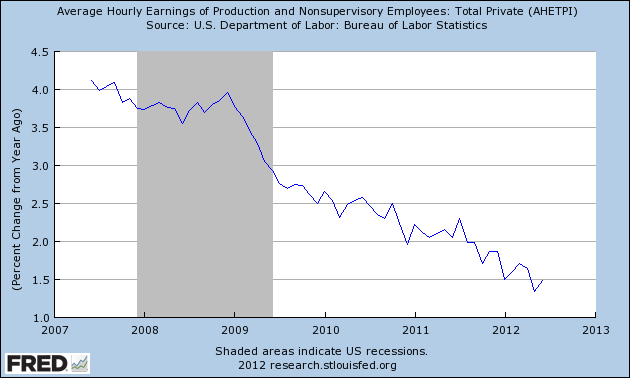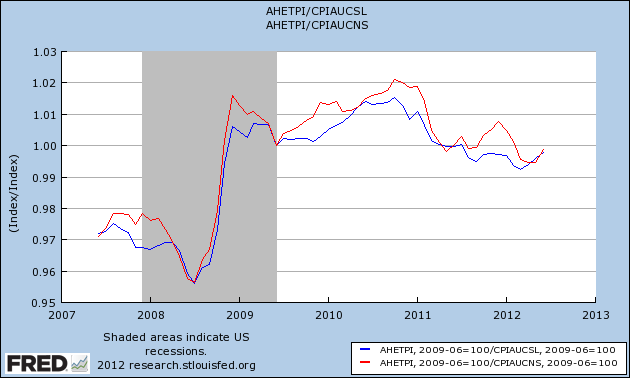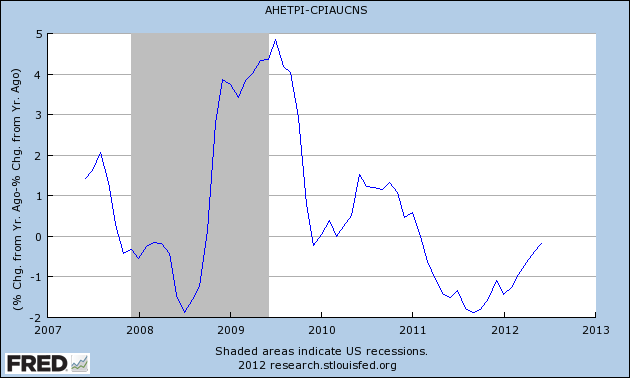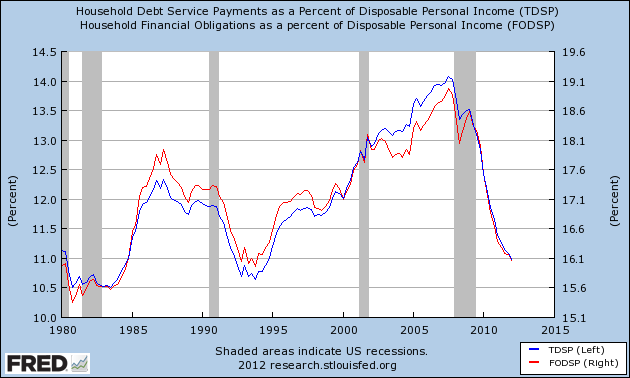- by New Deal democrat
In the rear view mirror, the big number reported this past week was 2nd quarter GDP. The initial throw of the dart came in at +1.5%. This is poor but still positive and not as poor as many had feared. Stay tuned for the revisions over the next several months. Monthly data reported included new home sales, falling from an upwardly revised May number. Durable goods taken as a whole rose, but core capital goods fell. Both measures of capital goods spending have been stalled since February. Consumer sentiment declined to its low of the year. This continues the recent slew of weakly positive or even negative news.
My weekly look at the high frequency weekly indicators are not meant to be predictive at all. Rather, if monthly or quarterly data is "looking in the rear view mirror," weekly data is much closer to observing events in real time. Although weekly data can be noisy, turns will show up here before they show up in monthly or quarterly data.
Let's start again this week with Same Store Sales, which remained mixed but positive, and Gallup was negative.
The ICSC reported that same store sales for the week ending July 21 rose 1.0% w/w, and were up +3.3% YoY. Johnson Redbook reported a 1.3% YoY gain. Shoppertrak, which has been very erratic, reported a +3.4% YoY gain.
The 14 day average of Gallup daily consumer spending, at $68 was $3 under last year's $71 for this period. This is the sixth week in a row in which consumer spending has weakened significantly, and the second worst YoY comparison in two months for the Gallup report. One year ago, sales were building to a good "back to school season" that peaked in early August. Since the beginning of June, however, sales have been in decline. This remains a red flag showing that consumers have turned cautious and that caution has continued through July.
Employment related indicators were also mixed to strongly positive this week:
The Department of Labor reported that Initial jobless claims fell 33,000 from the prior week's unrevised figure, down to 353,000. The four week average fell 8250 to 367,250. The lowest 4 week average during the entire recovery has been 363,000. This number does not appear to be compatible at all with further economic weakness.
The Daily Treasury Statement for the first 18 reporting days of July was $124.7 B vs. $123.3 B a year ago, a very slight +1.1% improvement. For the last 20 days ending on the third Thursday in July, $134.4 B was collected vs. $129.7 B for the same period in 2011, for a gain of 3.6%.
The American Staffing Association Index rose by 4 to 92. This is simply a rebound from the July 4 reporting week. This index has been generally flat for the last three months at 93 +/-1, mirroring its 2nd quarter flatness last year. If this index does not rise back to 93 next week, that would indicate further weakness.
The energy choke collar remains close to re-engaging:
Gasoline prices rose again last week, up .06 to $3.49. Oil prices per barrel feel slightly for the week, down close to $2 at $90.13. Gasoline usage, at 8660 M gallons vs. 8999 M a year ago, was off -3.8% The 4 week average at 8802 M vs. 9088 M one year ago is off -3.1%, still a significant YoY decline; however, June and early July of 2011 were the only months after March 2011 where there was a YoY increase in usage, so the YoY comparison now is especially difficult. This will definitely change in a week or two.
Bond prices and credit spreads both decreased again:
Weekly BAA commercial bond rates fell ..05% to 4.85%. These are the lowest yields in over 45 years. Yields on 10 year treasury bonds were flat at 1.52%. The credit spread between the two declined to 3.33%, but is still closer to its 52 week maximum than minimum. The recent collapse in bond yields shows fear of deflation due to economic weakness.
Housing reports remained mixed:
The Mortgage Bankers' Association reported that the seasonally adjusted Purchase Index declined -2.8% from the week prior, and were also down approximately -3.2% YoY, back into the middle part of its two year range. The Refinance Index rose 1.8% to another 3 year high.
The Federal Reserve Bank's weekly H8 report of real estate loans this week fell -0.1%. The YoY comparison rose to 1.1%. On a seasonally adjusted basis, these bottomed in September and are up +1.2%.
YoY weekly median asking house prices from 54 metropolitan areas at Housing Tracker were up + 2.4% from a year ago. YoY asking prices have been positive for almost 8 months, and remain higher than at any point last year.
Money supply was positive despite now being compared with the inflow tsunami of one year ago:
M1 rose +0.1% last week, and was up +3.1% month over month. Its YoY growth rate rose to +17.4%, so Real M1 is up 14.6% YoY. M2 rose 0.4% for the week, and was up 0.7% month/month. Its YoY growth rate increased to 8.9%, so Real M2 grew at +7.0%. Real money supply indicators after slowing earlier this year, have increased again, and YoY comparisons are holding generally steady.
Rail traffic turned mixed again, and the diffusion index was quite poor:
The American Association of Railroads reported a +1.9% increase in total traffic YoY, or +9,700 cars. Non-intermodal rail carloads were down -1.9% YoY or -5600, as coal hauling once again turned negative positive, and was joined by agricultural commodities and also some mining and metallic commodities, so negative comparisons are up to 13 of the 20 carload types, a new high. Intermodal traffic, however, was up 14,300 or 6.2% YoY.
Turning now to high frequency indicators for the global economy:
The TED spread declined .02 to 0.35, another new 52 week lows. The one month LIBOR declined very slightly 0.2460. It has risen significantly above its recent 4 month range, it remains well below its 2010 peak, and has still within its typical background reading of the last 3 years. Even with the recent scandal surrounding LIBOR, it is probably still useful in terms of whether it is rising or falling.
The Baltic Dry Index fell another 96 to 933. It is still 263 points above its February 52 week low of 670, although well below its October 2011 peak near 2200. The Harpex Shipping Index fell for the eighth straight week from 423 to 414, but is still up 39 from its February low of 375.
Finally, the JoC ECRI industrial commodities index fell from 118.73 to 117.10. This is still near its 52 week low. Its recent 10%+ downturn during the last few months remains a strong sign of all that the globe taken as a whole is slipping back into recession.
Once again we have weakness, now almost pervasive, in the coincident indicators such as rail traffic, shipping prices, commodity prices, and most especially Gallup's measure of consumer spending. The negative consumer sentiment and core capital goods orders could mean a 3rd negative LEI report in 4 months, which does not bode well for the near future. At the same time the long leading indicators of housing (especially refinancing), real money supply, and corporate bond yields continue to be positive, joined this week by initial jobless claims.
This coming week, real income, auto sales, payrolls and average wage data will give us further hard information as to how far the weakness goes, and whether real consumer income is positive YoY for the first time in 1 1/2 years.
Have a nice weekend!


















































